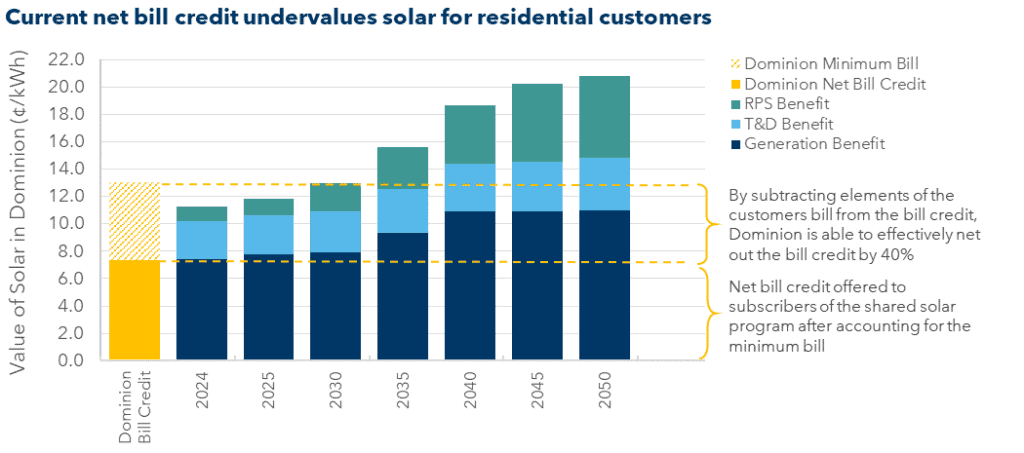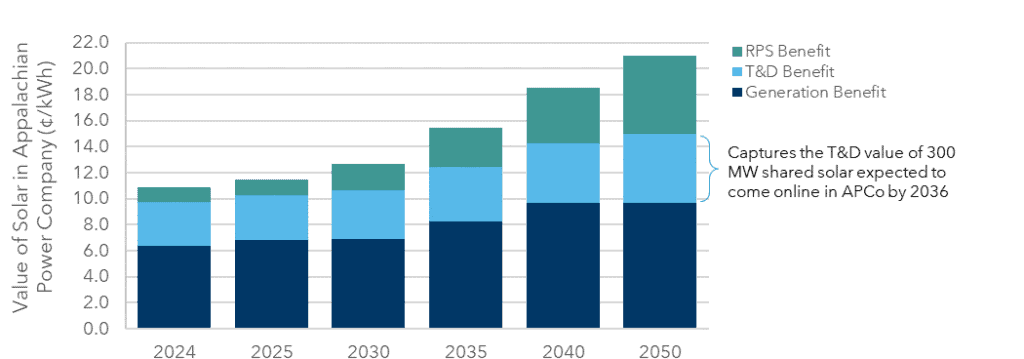Challenge: Quantify the benefit that Community Shared Solar (CSS) brings to Virginia’s two primary electric utilities and determine the value it can deliver to Virginia’s electric utility ratepayers over the 2024 to 2050 period in light of a proposed expansion of CSS in the state.
Solution: Combining robust modelling with a nuanced understanding of the region’s energy market, we identified previously unaccounted-for benefits that shared solar brings to the region’s primary electric utilities, specifically by reducing infrastructure and environmental compliance costs. Using this data, we determined that under the current structure, participants appear to be under-compensated and proposed an adjusted compensation rate for participants that would better reflect the full value of solar.
Impact: By identifying the full range of benefits shared solar brings to the grid, regulators have a more accurate picture of shared solar’s overall value and can make better-informed policy and investment decisions that ensure a fair, equitable and healthy electricity market.
Dunsky’s Approach to Determining the Value of Shared Solar
The Coalition of Community Solar Access (CCSA) is seeking to expand Virginia’s Shared Solar Program by 2,000MW. CCSA retained Dunsky to quantify the generation, transmission, distribution, and environmental value that shared solar provides to Virginia’s two primary electric utilities, Virginia Electric Power Company (operating as Dominion Energy) and Appalachian Power Company (Appalachian). This was then used to assess the appropriate level of compensation for Shared Solar Program participants.
To do this, Dunsky developed a framework to identify the technology-neutral value stack that can be attributed to generation resources[1]. This included calculating:
- Generation Benefits: This includes the value of Avoided Energy, Avoided Generation Capacity, Avoided Ancillary Services, Avoided Line Losses, Hedging/ Wholesale Risk Premium, and Wholesale Market Price Suppression Benefits through Demand Reduction Induced Price Effect Benefits (DRIPE).
- Transmission and Distribution (T&D) Benefits: This includes Transmission Charges, Avoided Transmission Capacity costs, and Avoided Distribution Capacity costs.
- Renewable Portfolio Standard Benefits: This Avoided Renewable Portfolio Standard (RPS) Compliance Costs.
With the value stack components set, we then applied a representative solar output profile to determine shared solar’s total and net[2] value contributions for each of the two utilities within the state (Virginia Electric and Power Company, also called Dominion, and the Appalachian Company) and finally, establish the true value of shared solar for the period 2024-2050.
Shared Solar is Undervalued Based on Grid Benefits
Our study concluded that distribution-system connected solar can provide significant benefits by offsetting the utility’s transmission charges and deferring transmission and distribution system upgrades.
If CCSA’s proposed program expansion were to go through, it could offer $126 million of total benefits over the 2024-2026 period and $5 billion over the 2024 to 2050 time period. Additionally, under the current compensation structure, the utilities are projected to accrue $64 million in net benefits from 2024-2026 and over $2.4 billion from 2024 to 2050. This suggests that more value could be returned to program participants via the bill credits they receive, which would compensate participants more equitably, and encourage broader participation and increased shared solar facility development in the state.
The graphs below indicate the calculated value of solar in both Dominion and Appalachian territories:


The study found that utilities could reduce the volumetric charges applied to shared solar customers by up to 80% and still reap a net benefit of $15 million from 2024-2026 and over $365 million from 2024 to 2050 based on the total value that shared solar delivers to the system. Ensuring a more equitable distribution of shared solar benefits could increase the attractiveness of the Shared Solar Program and, in turn, incentivize developers to build more shared solar facilities in the state. Ultimately, this would be a win-win situation as it would support substantial expansion of the shared solar program and help Virginia mitigate its capacity and energy shortfalls while putting it on the path of 100% clean electricity by 2050.
To learn more about the work conducted as part of this study, read the full report or contact us at info@dunsky.com.
[1] This analysis was conducted by leveraging publicly available information from PJM and utility-specific reports such as integrated resource plans (IRP), annual market outlooks, and solar forecast reports.
[2] Net value contributions considered the total benefits delivered by shared solar to the utilities, but removed the compensation the utilities pay to Shared Solar Participants.


